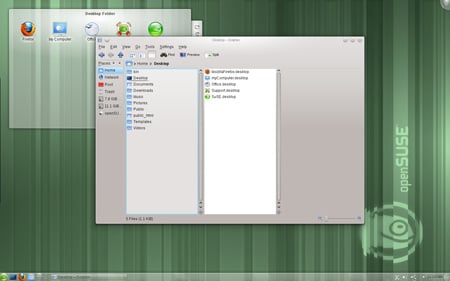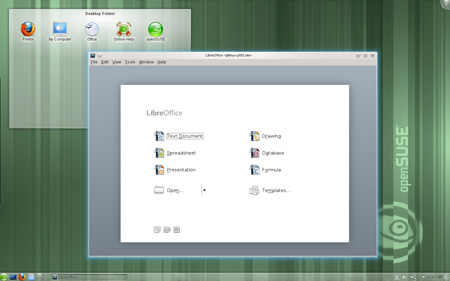Original URL: https://www.theregister.com/2011/03/14/opensuse_11_point_4_review/
openSUSE 11.4 rocks despite missing GNOME
Speed, LibreOffice, and more
Posted in OSes, 14th March 2011 03:17 GMT
Review openSUSE 11.4 brings a host of KDE and GNOME updates, the first release of OpenOffice fork LibreOffice, and numerous speed improvements.
Perhaps the biggest news, though, is what's not included. That would be GNOME 3.0.
Unfortunately for openSUSE fans, the distro's release schedule just didn't quite mesh with GNOME's, so GNOME 3.0 will have to wait for openSUSE 11.5, due at the end of the year.
Perhaps another reason for GNOME 3's absence is that KDE is the default openSUSE desktop. Prior to the release of openSUSE 11.3 last year, the openSUSE project announced it would shift its default desktop to KDE. While the distro is still ultimately desktop agnostic - the DVD installer packages both KDE and GNOME - the project is clearly putting the emphasis on keeping up with KDE ahead of GNOME.

openSUSE 11.4 puts its emphasis on KDE for the desktop
OpenSUSE 11.3 shipped with KDE 4.4, but this time around KDE has been bumped all the way to 4.6, leap-frogging right over KDE 4.5 to offer all the latest and greatest that Plasma has to offer.
Notable updates in KDE 4.6 include a smarter power management panel and a new Bluetooth back end that makes it easier to share files among Bluetooth devices. KDE 4.6 also features faceted searching via a new filter panel that enables you to browse your indexed files using their metadata - dates, rating, type and more.
The KDE development team recently switched the project over to the Git version control system and, as part of that move, Dolphin now supports Git repositories. Using the new Git plugin lets you to update and commit right from the GUI - a nice touch that devs will no doubt appreciate.
KDE's default apps also see some improvements in this release, including some social web enhancements to Digikam and KSnapshot, which can both now link up to Flickr, Facebook and Picasa for easy photo sharing.
If you've got a netbook the revamped Plasma Netbook Workspace has seen a considerable makeover and, for my money, handily beats GNOME-based efforts. The KDE Netbook Workspace strikes a nice balance between optimizing for small screens and still ensuring that you have a "normal" desktop when you need it.
In openSUSE's KDE you'll also find several extra apps that KDE users typically love but are not technically part of the KDE Software Compilation release - like Amarok and KOffice as well as painting application Krita.
On the GNOME side of the coin, openSUSE 11.4 offers GNOME 2.32 - the end of the line for GNOME 2.x. Technically you can use the new GNOME 3 with openSUSE 11.4, but it's a beta version of GNOME 3 and I wouldn't suggest it for everyday use.
GNOME 2.32 doesn't have any dramatic changes from previous releases, but openSUSE has changed things up a bit by switching from OpenOffice to the new LibreOffice.
Fork, yeah: LibreOffice replaces OpenOffice
LibreOffice came about last year when the majority of OpenOffice developers, concerned about the future of the project under new owner Oracle, broke away. The Open Document Foundation forked the OpenOffice code and rebranded it Libre Office.
Fedora, Red Hat and Ubuntu are also jumping ship to the new LibreOffice, making it, in effect, the new default office suite for Linux, but openSUSE gets the distinction of shipping it first.
At the moment the LibreOffice fork of OpenOffice isn't radically different from its older sibling, though you will find a few new features in this release, including a new, improved search bar and a revamped print dialog. The best news though is that, for now at least, most OpenOffice plug-ins seem to still work with LibreOffice. That may change as time goes on and the two projects move further apart, but hopefully, with the majority of the Linux community moving to LibreOffice, plugin developers will follow suit.
The latest version of openSUSE also sees Firefox 4, still a beta at the time of writing, as the default web browser. The Firefox 4 beta was stable enough, though in some cases your favorite plug-ins might not yet be updated. If Firefox isn't your bag, Chromium, the open source version of Google Chrome, is available in the main contrib repository.

Reassuringly, OpenOffice plug-ins still work with the new LibreOffice
Other GNOME apps have also been updated to the latest stable versions including the latest releases of Banshee, openSUSE's default music app, Evolution, the default mail client and F-Spot, which - despite the popularity of Shotwell in other distros - remains the default photo application for openSUSE 11.4. OpenSUSE throws in a few extra apps as well, like GIMP and Inkscape for graphics work and the very handy GNOME Do for launching applications and searching for files.
openSUSE 11.4 includes the updated Linux kernel, version 2.6.37, which brings several new features including multi-processor support for the ext4 filesystem, openSUSE's default. Provided you have a dual-core machine, the new kernel should bring a significant speed boost, particularly when transferring large files. The new kernel also brings the usual spate of new hardware drivers, including drivers for some new input devices from manufacturers like Wacom.
Installing openSUSE from the DVD was a breeze, easier in fact than installing Windows 7. Thankfully openSUSE automatically sets up disk partitions, the one installation task that often confuses Linux newcomers. When it comes to speed, this release is no slouch, both the GNOME and KDE desktops were snappy and well stocked with all the default apps most users would ever need.
On the GNOME side there is the peculiar menu-bar setup that may throw off users coming from other distros. Rather than the typical GNOME menu items on the top bar, openSUSE ships with its own custom GNOME menu that cops the look and function of the Windows start menu. Fortunately, a few preferences tweaks and you can have the typical GNOME menu bar in the top menu bar.
OpenSUSE also proved particularly snappy in virtual machine, even with very little RAM (512MB). In fact it was difficult to tell that it was a virtual machine, not a native installation. OpenSUSE is also aware of when it's running in a virtual machine and will automatically install a set of virtualized drivers for improved performance.
Overall openSUSE 11.4 offers a stable, fast user experience regardless of the desktop you use. The speed, coupled with some nice new applications for both KDE and GNOME, will make 11.4 a worthwhile update for any openSUSE fan. ®